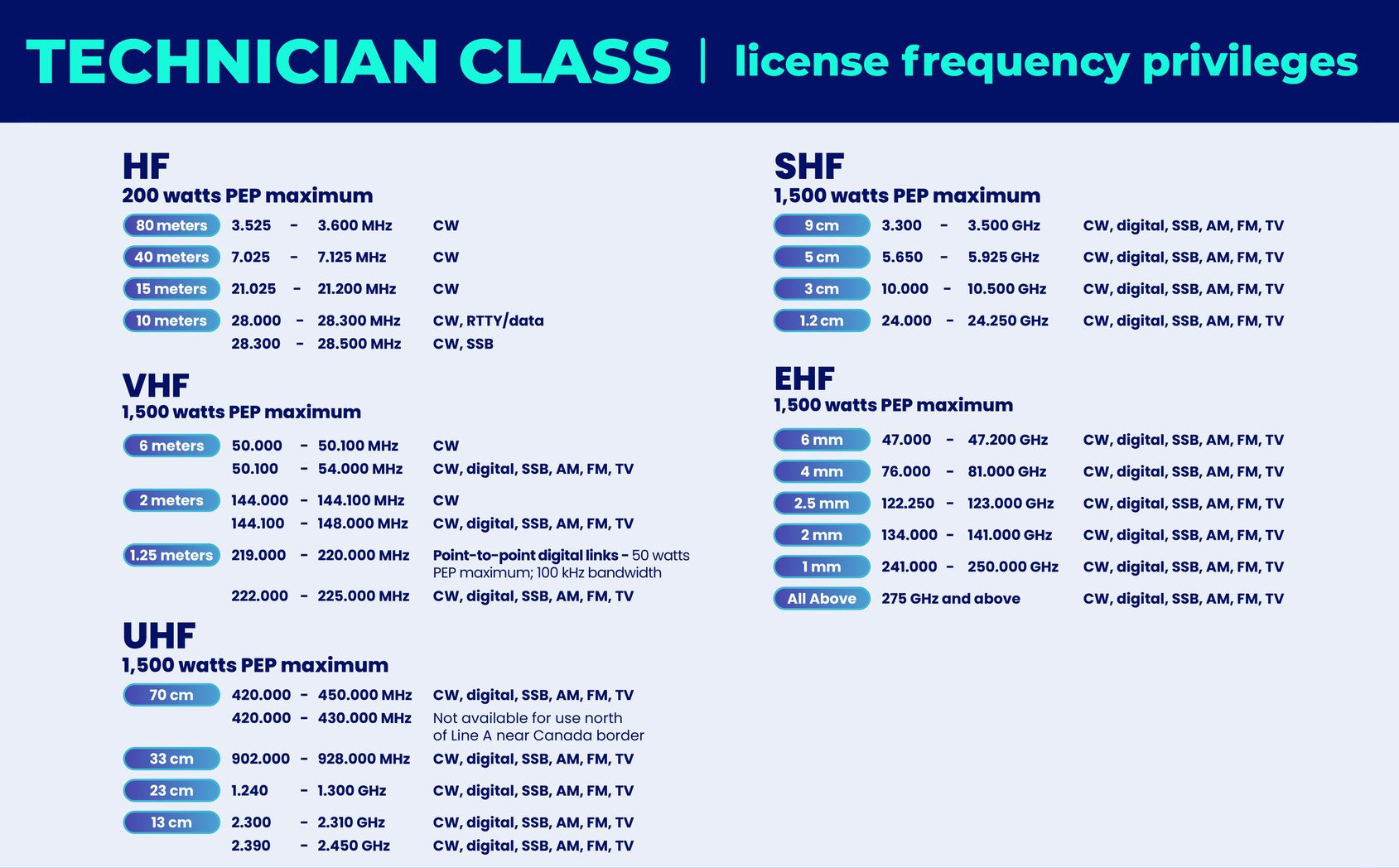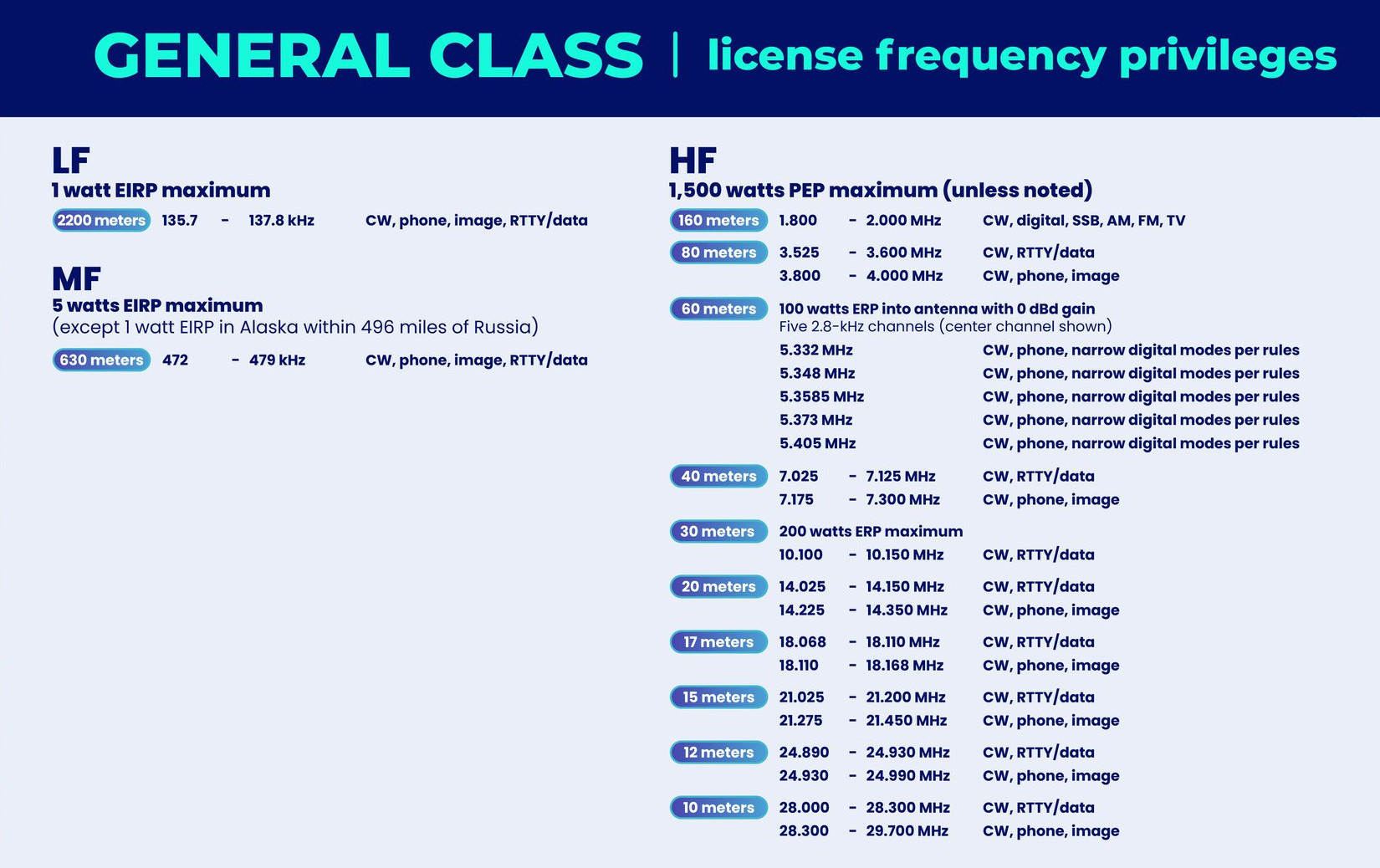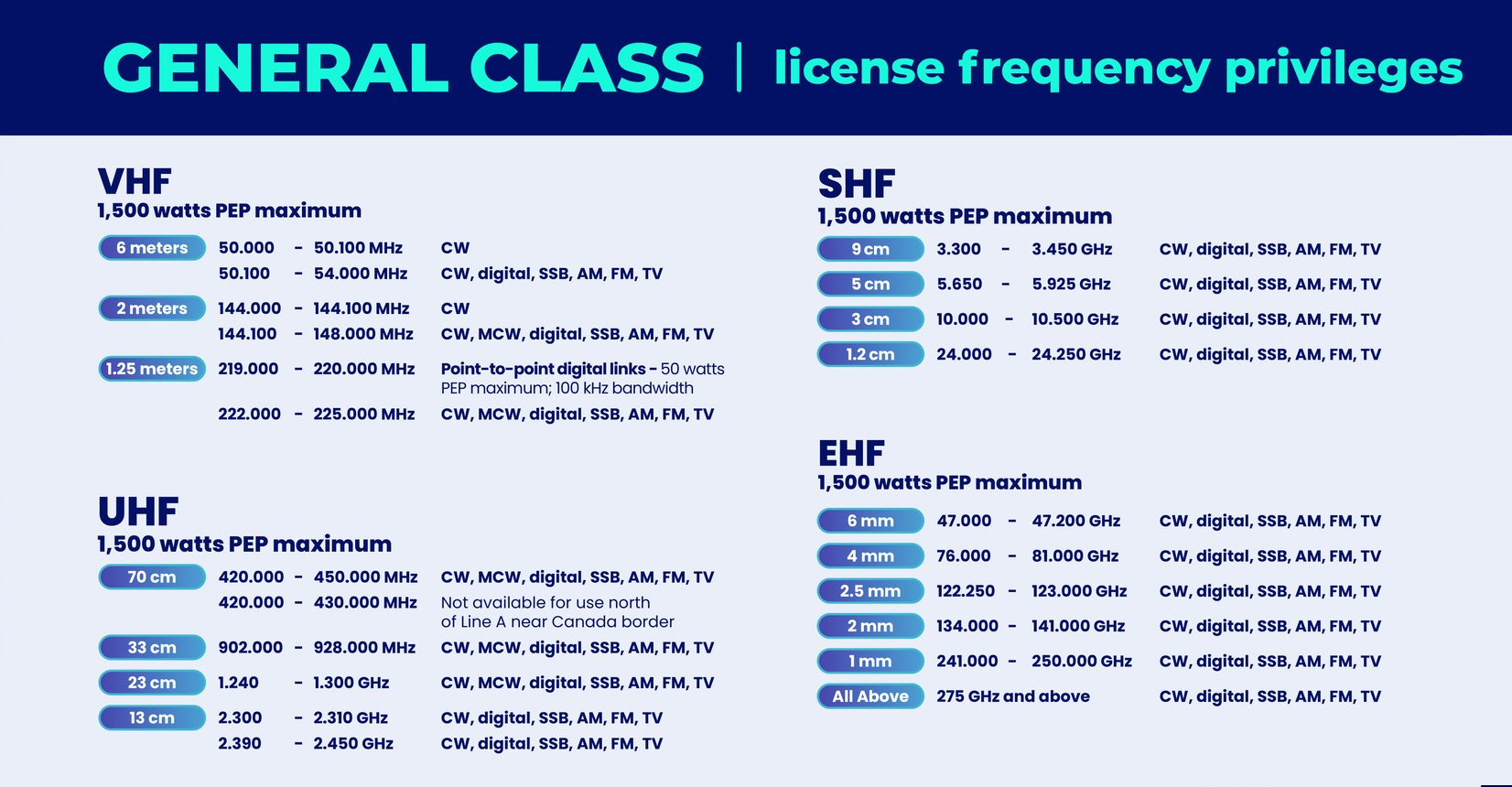HAM (and Others) Bands
- HF is the range from 3 to 30 MHz
- VHF is between 30 and 300 MHz
- UHF is between 300 and 3000 MHz.
Ham Radio Frequencies, Types of Radio Eemissions.
Band Plans
Technician License Privileges

General License Privileges


160m HF band (1.8-2.0 MHz)
| Freq | Use |
|---|---|
| 1.800 - 2.000 | CW |
| 1.800 - 1.810 | Digital Modes |
| 1.810 | CW QRP |
| 1.843-2.000 | SSB, SSTV and other wideband modes |
| 1.910 | SSB QRP |
| 1.995 - 2.000 | Experimental |
| 1.999 - 2.000 | Beacons |
80m HF band (3.500-4.000 MHz)
| ITU Region | Band |
|---|---|
| 1 | 3.5 – 3.8 MHz |
| 2 | 3.5 – 4.0 MHz |
| 3 | 3.5 – 3.9 MHz |
Upper part of the 80m Band in ITU Region 2 countries, is commonly named as 75m band.
The 80-meter band is considered the most reliable all-season long-distance (DX) band. It is popular for DX contacts at night and reliable for medium-distance contacts during the day. In the US and Canada, a portion of this band allows for single-sideband voice and AM voice transmissions.
This band is good for local communications during the day, and hardly ever good for communications over intercontinental distances during daylight hours. During late afternoon and night , when noise decreases, it can be effective even for worldwide communications.
Bands below 10 MHz use lower sideband (LSB).
| Freq | Use |
|---|---|
| 3.590 | RTTY/Data DX |
| 3.570-3.600 | RTTY/Data |
| 3.790-3.800 | DX window |
| 3.845 | SSTV |
| 3.885 | AM calling frequency |
60m HF band (5 MHz)
- Only one signal at a time is permitted on any channel
- Maximum effective radiated output is 100 W PEP
US 60 meter channels Center, Dial
| Freq | Use |
|---|---|
| 5330.5 | USB phone1 and CW/RTTY/data2 |
| 5346.5 | USB phone1 and CW/RTTY/data2 |
| 5357.0 | USB phone1 and CW/RTTY/data2 |
| 5371.5 | USB phone1 and CW/RTTY/data2 |
| 5403.5 | USB phone1 and CW/RTTY/data2 |
- USB is limited to 2.8 kHz
- CW and digital emissions must be centered 1.5 kHz above the channel frequencies indicated in the above chart
40m HF band (7.000-7.300 MHz)
| ITU Region | Band |
|---|---|
| 1 | 7.0 – 7.2 MHz |
| 2 | 7.0 – 7.3 MHz |
| 3 | 7.0 – 7.2 MHz |
The 40-meter band is considered the most reliable all-season long-distance (DX) band. It is popular for DX contacts at night and reliable for medium-distance contacts during the day. This band is now free of other users due to the shutdown of many shortwave broadcasting services.
Bands below 10 MHz use lower sideband (LSB).
| Freq | Use |
|---|---|
| 7.040 | RTTY/Data DX |
| 7.080-7.125 | RTTY/Data |
| 7.171 | SSTV |
| 7.290 | AM calling frequency |
30m HF band (10.1-10.15 MHz)
| Freq | Use |
|---|---|
| 10.130-10.140 | RTTY |
| 10.140-10.150 | Packet |
20m HF band (14.000-14.350 MHz)
The 20-meter band is considered the most popular DX band and is usually most active during the daytime. It is commonly used for DX operations in all modes. This band permits long distance contacts, even when other bands are closed, and this is the reason why it is particularly crowded during contests.
Bands 10 MHz and above, use upper sideband (USB).
| Freq | Use |
|---|---|
| 14.070-14.095 | RTTY |
| 14.095-14.0995 | Packet |
| 14.100 | NCDXF Beacons |
| 14.1005-14.112 | Packet |
| 14.230 | SSTV |
| 14.286 | AM calling frequency |
17m band (18.068-18.168 MHz)
| Freq | Use |
|---|---|
| 18.100-18.105 | RTTY |
| 18.105-18.110 | Packet |
15m band (21.0-21.45 MHz)
| Freq | Use |
|---|---|
| 21.070-21.110 | RTTY/Data |
| 21.340 | SSTV |
12m band (24.89-24.99 MHz)
| Freq | Use |
|---|---|
| 24.920-24.925 | RTTY |
| 24.925-24.930 | Packet |
CB band
27.065 Channel 9 on CB Radios, commonly considered the emergency frequency for CB and is still monitored by teams and law enforcement 27.185 Channel 19 on CB Radios, the most used CB channel, especially active around highways
10m HF band (28.000-29.700 MHz)
The 10m band is a portion of the shortwave radio spectrum internationally allocated to amateur radio and amateur satellite use on a primary basis.
The best time for long-distance 10m band propagation via the F layer - from dawn to shortly after sunset during periods of high sunspot activity.
| Freq | Use |
|---|---|
| 28.000-28.070 | CW |
| 28.070-28.150 | RTTY |
| 28.150-28.190 | CW |
| 28.200-28.300 | Beacons |
| 28.300-29.300 | Phone |
| 28.680 | SSTV |
| 29.000-29.200 | AM |
| 29.300-29.510 | Satellite Uplinks or Downlinks |
| 29.520-29.590 | Repeater Inputs |
| 29.600 | FM Simplex |
| 29.610-29.700 | Repeater Outputs |
6m VHF band (50.000-54.000 MHz)
The 6-meter band is best suited for communicating via meteor scatter.
| Freq | Use |
|---|---|
| 50.0-50.1 | CW, beacons |
| 50.060-50.080 | beacon subband |
| 50.1-50.3 | SSB, CW |
| 50.10-50.125 | DX window |
| 50.125 | SSB calling |
| 50.3-50.6 | All modes |
| 50.6-50.8 | Nonvoice communications |
| 50.62 | Digital (packet) calling |
| 50.8-51.0 | Radio remote control (20-kHz channels) |
| 51.0-51.1 | Pacific DX window |
| 51.12-51.48 | Repeater inputs (19 channels) |
| 51.12-51.18 | Digital repeater inputs |
| 51.5-51.6 | Simplex (six channels) |
| 51.62-51.98 | Repeater outputs (19 channels) |
| 51.62-51.68 | Digital repeater outputs |
| 52.0-52.48 | Repeater inputs (except as noted; 23 channels) |
| 52.02, 52.04 | FM simplex |
| 52.2 | TEST PAIR (input) |
| 52.5-52.98 | Repeater output (except as noted; 23 channels) |
| 52.525 | Primary FM simplex - US Calling Frequency |
| 52.54 | Secondary FM simplex |
| 52.7 | TEST PAIR (output) |
| 53.0-53.48 | Repeater inputs (except as noted; 19 channels) |
| 53.0 | Remote base FM simplex |
| 53.02 | Simplex |
| 53.1, 53.2, 53.3, 53.4 | Radio remote control |
| 53.5-53.98 | Repeater outputs (except as noted; 19 channels) |
| 53.5, 53.6, 53.7, 53.8 | Radio remote control |
| 53.52, 53.9 | Simplex |
Airband (108-137 MHz)
Airband, US Aviation Frequencies.csv
| Freq | Use |
|---|---|
| 121.500 | Aircraft emergency frequency |
| 121.500 | Air Search and Rescue |
| 123.100 | Aviation Search and Rescue |
2m VHF band (144-148 MHz)
 is one of the most popular non-HF ham bands.
is one of the most popular non-HF ham bands.
| ITU Region | Band |
|---|---|
| 1 | 144 – 146 MHz |
| 2 | 144 – 148 MHz |
| 3 | 144 – 148 MHz |
Common repeater frequency offset: ±600kHz
| Freq | Use |
|---|---|
| 144.00-144.05 | EME, weak CW |
| 144.05-144.10 | General CW and weak signals |
| 144.10-144.20 | EME and weak-signal SSB |
| 144.200 | National calling frequency, SSB |
| 144.200-144.275 | General SSB operation |
| 144.275-144.300 | Propagation beacons |
| 144.30-144.50 | New OSCAR subband |
| 144.50-144.60 | Linear translator inputs |
| 144.60-144.90 | FM repeater inputs |
| 144.90-145.10 | Weak signal and FM simplex (145.01,03,05,07,09 are widely used for packet) |
| 145.10-145.20 | Linear translator outputs |
| 145.20-145.50 | FM repeater outputs |
| 145.50-145.80 | Miscellaneous and experimental modes |
| 145.80-146.00 | OSCAR subband |
| 146.01-146.37 | Repeater inputs |
| 146.40-146.58 | Simplex |
| 146.520 | National Simplex Calling Frequency |
| 146.61-146.97 | Repeater outputs |
| 147.00-147.39 | Repeater outputs |
| 147.42-147.57 | Simplex |
| 147.60-147.99 | Repeater inputs |
Notes:
- The frequency 146.40 MHz is used in some areas as a repeater input. This band plan has been proposed by the ARRL VHF-UHF Advisory Committee.
- 146.520 - 2m band National Simplex Channel
MURS Band (151 MHz)
151.820 Multi Use Radio Service (MURS) 151.880 Multi Use Radio Service (MURS)
155 MHz
155.160 Land Search and Rescue
Marine Radio Band (156 MHz)
156.800 Marine Distress Safety and Calling (Marine Radio Channel 16) 157.100 U.S. Coast Guard Liaison (Marine Radio Channel 22) 156.300 Marine Intership Safety (Marine Radio Channel 6)
US CA Railroad Channels (159-161 MHz)
161.205 Railroad Police Mutual Aid
Weather Band (161-164 MHz)
Weather Radio, NOAA Weather Radio, National Oceanic and Atmospheric Administration (NOAA)
| MHz | Notes |
|---|---|
| 162.400 | NOAA / National Weather Service broadcast frequency |
| 162.425 | NOAA / National Weather Service broadcast frequency |
| 162.450 | NOAA / National Weather Service broadcast frequency |
| 162.475 | NOAA / National Weather Service broadcast frequency |
| 162.500 | NOAA / National Weather Service broadcast frequency |
| 162.525 | NOAA / National Weather Service broadcast frequency |
| 162.550 | NOAA / National Weather Service broadcast frequency |
| 161.650 | |
| 161.750 | |
| 161.775 | |
| 162.000 | |
| 163.275 |
All U.S. and Canadian stations transmit SAME codes a few seconds before the 1,050 Hz attention tone that allows more advanced receivers to respond only for certain warnings that carry a specific code for the local area. S
1.25m VHF band (219-220 MHz, 222-225 MHz)
The 1.25m band is primarily used for local communications.
| ITU Region | Band |
|---|---|
| 1 | NA |
| 2 | 222 – 225 MHz |
| 3 | NA |
223.500 1.25-meter band National Simplex Channel
222.0-222.150 Weak-signal modes 222.0-222.025 EME 222.05-222.06 Propagation beacons 222.1 SSB & CW calling frequency 222.10-222.15 Weak-signal CW & SSB 222.15-222.25 Local coordinator’s option; weak signal, ACSB, repeater inputs, control 222.25-223.38 FM repeater inputs only 223.40-223.52 FM simplex 223.52-223.64 Digital, packet 223.64-223.70 Links, control 223.71-223.85 Local coordinator’s option; FM simplex, packet, repeater outputs 223.85-224.98 Repeater outputs only
Note: The 222 MHz band plan was adopted by the ARRL Board of Directors in July 1991.
Military Air Distress 243.0 MHz, 406 MHz
70cm UHF band (430-440 MHz)
The 70cm band is a popular ham band due to the ready availability of equipment in both new and used markets. Amateurs usually use the band for FM or digital voice communications through repeaters, as well narrow band modes (analog and digital) for long-distance communications (called “DX”, including Moon bounce). The band is also popular for Amateur Satellite Service.
Common repeater frequency offset: ±5MHz
446.000 70 cm band National Simplex Channel
GMRS Band (462-467 MHz)
GMRS band is shared with Family Radio Service (FRS).
Channels:
| Ch | MHz Rx | Notes |
|---|---|---|
| 1 | 462.5625 | Shared FRS/GMRS simplex |
| 2 | 462.5875 | Shared FRS/GMRS simplex |
| 3 | 462.6125 | Shared FRS/GMRS simplex |
| 4 | 462.6375 | Shared FRS/GMRS simplex |
| 5 | 462.6625 | Shared FRS/GMRS simplex |
| 6 | 462.6875 | Shared FRS/GMRS simplex |
| 7 | 462.7125 | Shared FRS/GMRS simplex |
| 8 | 467.562 | Shared FRS/GMRS simplex5 |
| 9 | 467.5875 | Shared FRS /GMRS simplex |
| 10 | 467.6125 | Shared FRS/GMRS simplex |
| 11 | 467.6375 | Shared FRS/GMRS simplex |
| 12 | 467.6625 | Shared FRS/GMRS simplex |
| 13 | 467.6875 | Shared FRS/GMRS simplex |
| 14 | 467.7125 | Shared FRS/GMRS simplex |
| 15 | 462.5500 | Shared FRS/GMRS simplex, repeater output. |
| 16 | 462.5750 | Shared FRS/GMRS simplex, repeater output. |
| 17 | 462.6000 | Shared FRS/GMRS simplex, repeater output. |
| 18 | 462.6250 | Shared FRS/GMRS simplex, repeater output. |
| 19 | 462.6500 | Shared FRS/GMRS simplex, repeater output. |
| 20 | 462.6750 | Shared FRS/GMRS simplex, repeater output, National GMRS calling channel (CTCSS tone 141.3 Hz). |
| 21 | 462.7000 | Shared FRS/GMRS simplex, repeater output. |
| 22 | 462.7250 | Shared FRS/GMRS simplex, repeater output. |
| 23 | 467.5500/462.5500 | repeater input. The output frequency of this repeater is the input frequency minus 5 MHz. |
| 24 | 467.5750/462.5750 | repeater input. The output frequency of this repeater is the input frequency minus 5 MHz. |
| 25 | 467.6000/462.6000 | repeater input. The output frequency of this repeater is the input frequency minus 5 MHz. |
| 26 | 467.6250/462.6250 | repeater input. The output frequency of this repeater is the input frequency minus 5 MHz. |
| 27 | 467.6500/462.6500 | repeater input. The output frequency of this repeater is the input frequency minus 5 MHz. |
| 28 | 467.6750/462.6750 | repeater input. The output frequency of this repeater is the input frequency minus 5 MHz. |
| 29 | 467.7000/462.7000 | repeater input. The output frequency of this repeater is the input frequency minus 5 MHz. |
| 30 | 467.7250/462.7250 | repeater input. The output frequency of this repeater is the input frequency minus 5 MHz. |
462.675 GMRS emergency frequency (Channel 20)
33cm UHF band (902-928 MHz)
The 33cm band is primarily used for very local communications.
906.500 33 cm band National Simplex Channel
23cm UHF band (1240-1300 MHz)
The 23cm band.
1294.500 23 cm band National Simplex Channel
13cm UHF band (2.3-2.450 GHz)
The 13cm band.